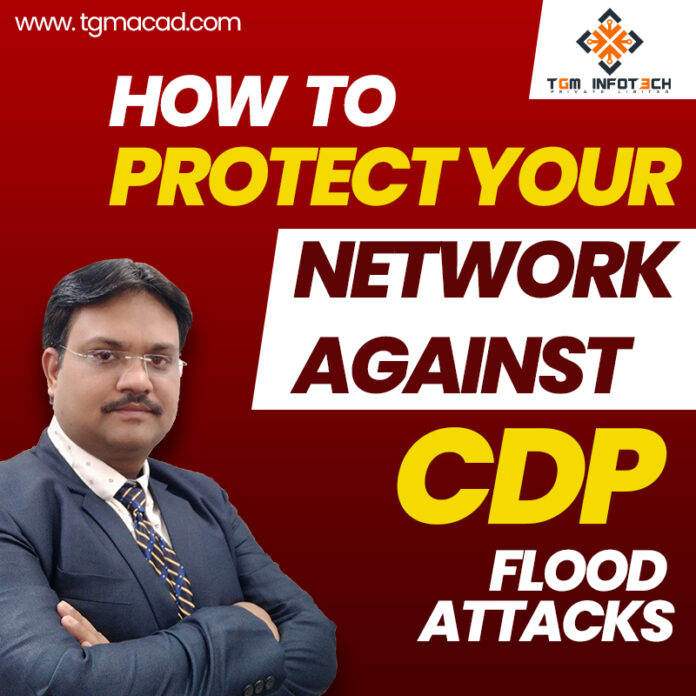How to Protect Your Network Against CDP Flood Attacks
Introduction
In the world of network security, CDP flood attacks pose a serious threat to the stability and reliability of your network infrastructure. Cisco Discovery Protocol (CDP) is a useful tool for device discovery and information sharing, but in the wrong hands, it can be used to launch disruptive attacks. In this article, we’ll explore what CDP flood attacks are, the potential risks they pose, and most importantly, how to protect your network against them.
What is CDP
A “CDP flood attack” is a type of cyberattack that targets computer networks, particularly those using Cisco networking equipment. CDP stands for Cisco Discovery Protocol, which is a proprietary networking protocol used for device discovery and information sharing among Cisco devices. In a CDP flood attack, a malicious actor inundates the network with an excessive amount of CDP packets.
CDP packets are typically used by devices on the network to announce their presence and share information about their configurations. However, when an attacker floods the network with a high volume of these CDP packets, it can have several negative consequences, including:
1. Network Congestion:
The excessive CDP traffic can saturate the network, causing congestion and disrupting the normal flow of data.
2. Resource Overutilization:
Devices receiving an abundance of CDP packets may experience higher CPU and memory usage, potentially leading to degraded device performance.
3. Packet Loss:
The flood of CDP packets can lead to packet loss, which can affect the reliability of network services.

Understanding CDP Flood Attacks
CDP flood attacks involve malicious actors overwhelming a network segment with an excessive volume of CDP packets. These packets are usually used by network devices to announce themselves and share information about their configurations. However, when these packets flood the network, it can lead to several adverse consequences:
1. Network Congestion:
The inundation of CDP packets can saturate the network, leading to congestion that disrupts normal data traffic.
2. Resource Overutilization:
Network devices receiving an abnormally high volume of CDP packets may experience increased CPU and memory usage, potentially affecting device performance.
3. Packet Loss:
The excessive CDP packets can lead to packet loss, affecting the reliability of network services.
4. Unauthorized Device Discovery:
Attackers can exploit CDP flood attacks to identify vulnerable network devices, making them potential targets for further exploitation.
CCNA 200-301
CCNA Certification is globally recognized and it is respected by most companies across the globe. the course gives you a broad range of fundamental knowledge for all IT careers. The CCNA exam is designed to test the skills and knowledge required to install, configure, operate, and troubleshoot medium-sized switched and routed networks. To prepare for the CCNA 200-301 exam, candidates can study the course curriculum of CCNA, which covers a wide range of networking concepts and technologies. They can also use various study resources, such as e-books, online courses, and practice exams, to help them prepare for the exam

Protecting Against CDP Flood Attacks
Safeguarding your network against CDP flood attacks is paramount. Here are some effective strategies to help protect your network:
1. Disable CDP:
If CDP is not essential for your network, consider disabling it altogether. This will eliminate the possibility of CDP being used as an attack vector.
2. Implement Access Control Lists (ACLs):
Use ACLs to filter incoming traffic and restrict unwanted CDP packets.
3. Rate Limiting:
Implement rate limiting to control the number of CDP packets allowed per second. This can prevent network saturation.
4. Enable Authentication:
Configure authentication mechanisms such as MD5 for CDP packets to ensure that only trusted devices can exchange CDP information.
5. Regular Firmware Updates:
Keep your network devices up to date by applying the latest firmware updates to benefit from security patches and improvements.
6. Network Segmentation:
Segment your network to isolate critical devices from non-critical ones, reducing the impact of CDP flood attacks.

Conclusion
CDP flood attacks can disrupt network operations and compromise security. Understanding the risks and proactively implementing these protective measures is crucial to maintain the integrity and reliability of your network. By staying vigilant and prepared, you can effectively defend your network against the growing threat of CDP flood attacks and ensure the smooth operation of your network infrastructure.





